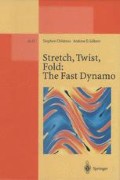Abstract
As we have seen in Chap. 2, numerical experiments using two-dimensional unsteady flows strongly suggest the existence of fast dynamos, and point toward a connection between computation with ε ≡ 0 and the limit of computations with ε > 0. In particular the flux conjecture appears justified in all cases of fast dynamo action that have been examined. For three-dimensional steady flows there is some support for fast dynamo action, but there are still perplexing gaps in our understanding of magnetic structure and its measurement. The flux conjecture seems to work for the Kolmogorov flow but has not been verified for the ABC 111 flow of §2.6.
Access this chapter
Tax calculation will be finalised at checkout
Purchases are for personal use only
Preview
Unable to display preview. Download preview PDF.
References
We shall not, in this monograph, make use of wavelets in the representation of the magnetic field obtained under iterated Lagrangian maps. However such a representation could be very useful in certain cases. The most natural connection is between the folded baker’s map and the Haar wavelet; see Strang (1989). The image of the field (1, 0) under the folded baker’s map is, as a function of y, a Haar wavelet. A second mapping produces two smaller wavelets, and the map is thus simply represented in a Haar wavelet decomposition.
It is interesting that a completely separate argument, given by Bayly & Childress (1988), leads to a similar estimate for flux growth in models based on a baker’s map. We represent the field by a spectrum function F(k) over arbitrary real wave numbers k, and replace the operator TSFS by Q, where QF(k) = \( \sqrt 2 \)F(k/2). With the L2 norm on (−∞, +∞), the operator Q doubles the norm but the flux, F(0), grows by a factor \( \sqrt 2 \).
Rights and permissions
Copyright information
© 1995 Springer-Verlag Berlin Heidelberg
About this chapter
Cite this chapter
(1995). Fast Dynamos in Maps. In: Stretch, Twist, Fold: The Fast Dynamo. Lecture Notes in Physics Monographs, vol 37. Springer, Berlin, Heidelberg. https://doi.org/10.1007/978-3-540-44778-8_3
Download citation
DOI: https://doi.org/10.1007/978-3-540-44778-8_3
Publisher Name: Springer, Berlin, Heidelberg
Print ISBN: 978-3-540-60258-3
Online ISBN: 978-3-540-44778-8
eBook Packages: Springer Book Archive

